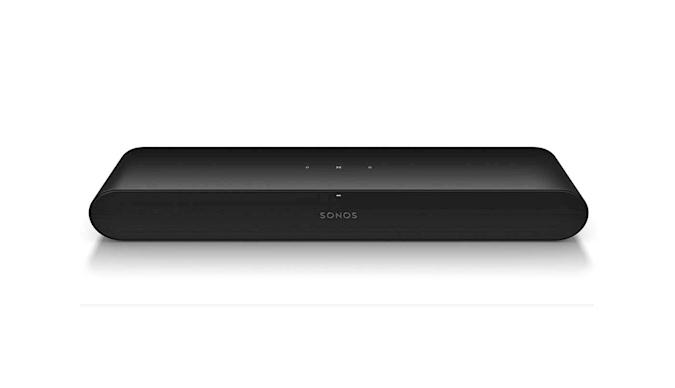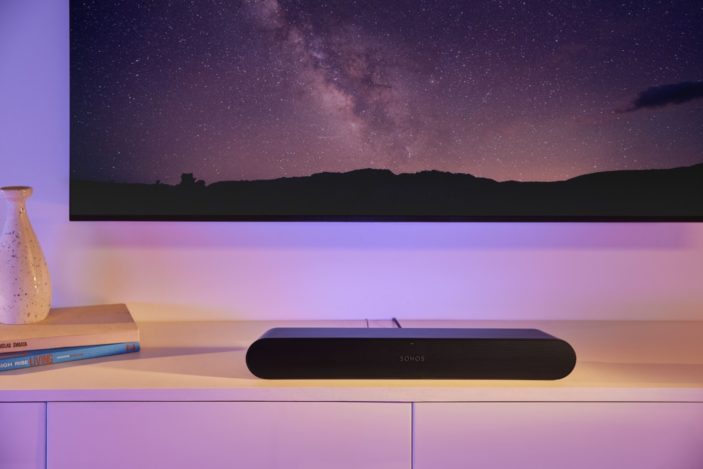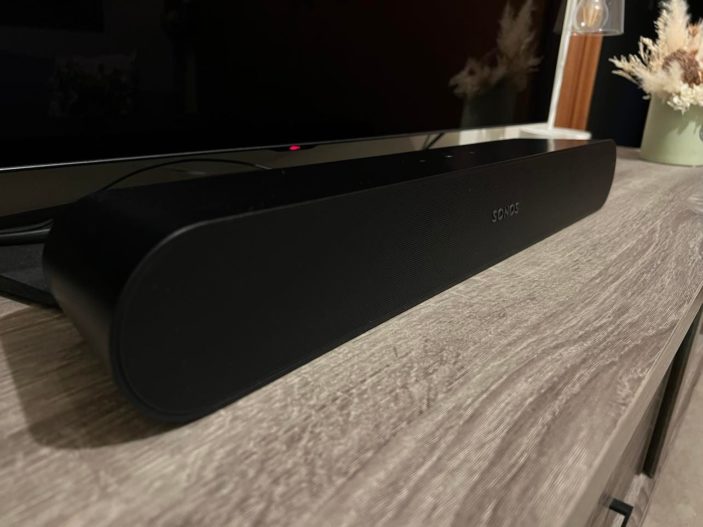
It’s no secret that Sonos has dominated the premium end of the audio landscape in recent years. Providing high quality audio and seamless connectivity, it’s definitely hard to argue with the results of the Sonos Arc soundbar or the Sonos Sub. Then there’s the price tag. While some may be put off by the expensive investment, Sonos have decided to try their hand at some budget friendly options, introducing the smaller Sonos Beam, to critical acclaim. Enter the Sonos Ray. This smaller sound bar serves as the little brother to both the Arc and Beam, aiming to provide quality audio to your living room. While Sonos has cut a few corners to bring the Ray to the market at an even lower price tag than the Beam, there’s no doubting that the Sonos Ray will either rival or outright beat most of the soundbars in its class.
Design
The Sonos Ray enters the Sonos range as the smallest soundbar available, at just 55cm wide. Both minimal and sleek, it’s bound to fit right into most living rooms, available in either black or white. It also looks the part, fitting in with its older siblings, featuring a polycarbonate grill and the usual touch controls on the top, to play and pause media, while adjusting volume.

Much like the value, this smaller size comes at a cost. Featuring a pair of mid woofers and two tweeters, Sonos have crammed as much as they can into a soundbar of this size, forgoing some of the more premium features that Sonos is known for, such as virtual Dolby Atmos decoding and HDMI support. The single optical connection is easy enough to set up with any TV, but this does leave a little to be desired here, as the Beam, which costs only a couple hundred dollars more, includes both these features.
Performance
These design choices might sound like criticisms, but when it comes to outright sound quality, the Sonos Ray truly shines. As previously mentioned, the Sonos Ray’s two mid woofers and two tweeters provide plenty of range and punch for most audio situations, including gaming, movies and general TV. Sound is generally clear and you’ll rarely get the soundbar to crackle in louder scenarios. However, it’s worth noting that unlike the Beam and Arc, the Ray is a stereo-only soundbar, meaning most of the dynamic range that would usually fill the four corners of your room might be lacking in larger viewing areas.
When listening to music, I would liken the Sonos Ray to the Sonos One speaker. While the Sonos One is a smart speaker, the Sonos Ray unfortunately lacks voice control. However, I would go as far to say that the overall sound is both clearer and crisper than any soundbar at this price, proving full audio and competent bass.

Unlike the Beam and Arc, the Sonos Ray lacks HDMI support, leaving users with an optical cable connection. While a HDMI connection is always the way to go wherever possible, I wasn’t surprised to see the quality of audio largely uncompromised. As previously mentioned, this means features like Dolby Atmos are absent here. This leads me to believe that Sonos are well aware of the criticisms, subtly hinting that this is not only a budget soundbar, but one made for secondary living rooms and bedrooms.
The Sonos Ray did surprise me for the most part, but stood out in one department in particular; voice clarity. Many would have encountered issues when watching Blu-Ray and 4K films in which dialogue is incredibly low while effects and music are outrageously loud, leaving the overall experience feeling unbalanced. Thanks to the inclusion of a speech enhancement option, the Sonos Ray boosts overall audio volume while leaving the remaining experience largely in tact, which is a must for constant movie watchers like myself.
Functionality
The Sonos App is once again your hub for overall control and customisation, fitting seamlessly into your current Sonos setup. It also works great with every major streaming service and even Apple Airplay 2. Beyond this, the Sonos app works exactly as you would expect. The only downside here is that with no HDMI support, you’ll have to pass you TV’s audio through the optical port and in turn use the Sonos app to control volume directly, unless you want to get up off the couch and control the volume manually. Yep, we wouldn’t either. Remotes can be synced to the Ray, but not all remotes are compatible, so this unfortunately comes down to trial and error.

While the Sonos Ray lacks much of the nifty software like Dolby Atmos, it’s not without some tricks. Apple device users can take advantage of Trueplay, which allows the Ray to utilise the iPhone or iPad’s microphone to automatically adjust and optimise sound according to the room’s acoustics. Unfortunately, Android users are currently unable to utilise this at the time of writing.
Verdict & Value
Overall, the Sonos Ray provides premium sound for its $399 price tag, outshining most if not all of the soundbars in its class. However, Sonos have definitely cut corners to bring such value with it. Should you be looking for a budget friendly option for the main loving room, I would still recommend the Sonos Beam for its voice control and Dolby Atmos. The lack of a HDMI input and Dolby Atmos as a result is not ideal, but the impressive sound quality and compact design are sure to bring the audio solution most users will be looking for, be it for a second living room or bedroom.
![]()
![]()
![]()
![]()
![]()
FOUR STARS (OUT OF FIVE)
Highlights: Sleek design; Solid audio quality; Speech Enhancement option is essential for movies
Lowlights: Stereo only soundbar; Heavy reliance on Sonos app; Lack of HMDI input
Manufacturer: Sonos
Price: A$399
Available: 7 June
Review based on unit supplied by Sonos.
